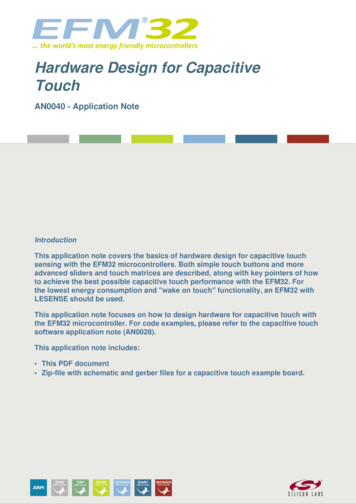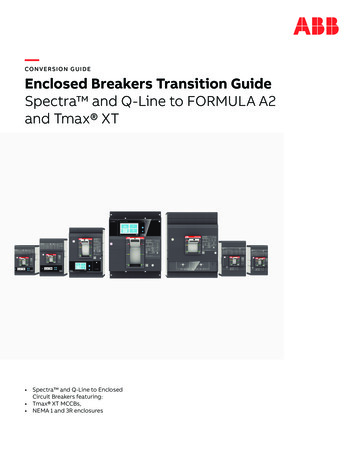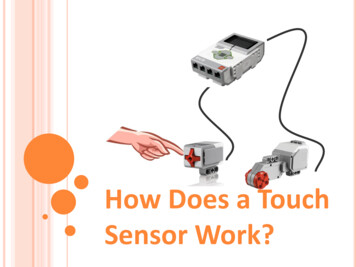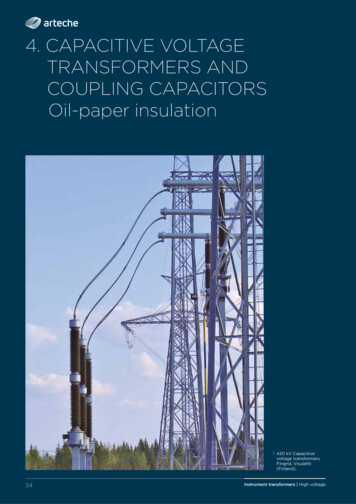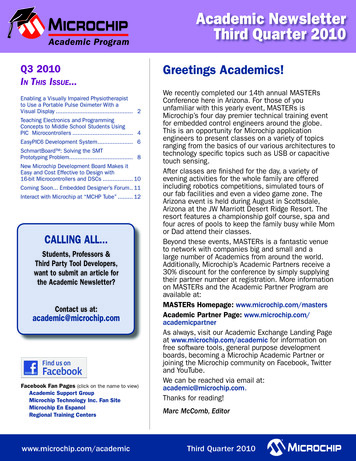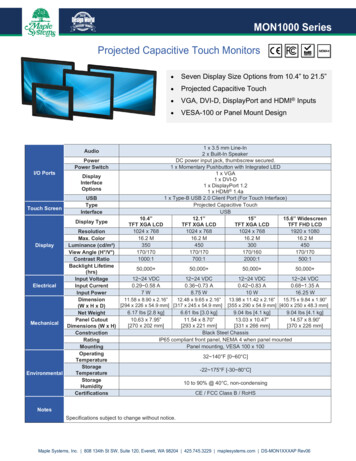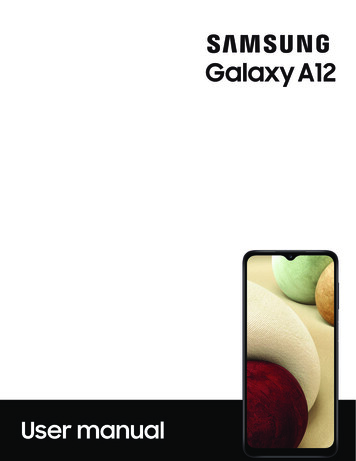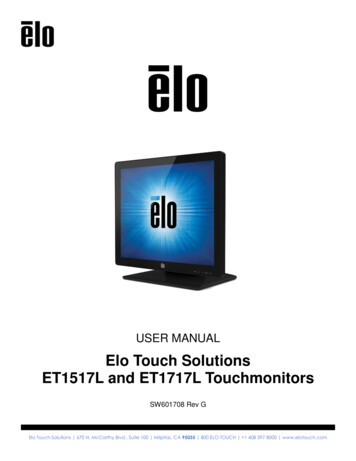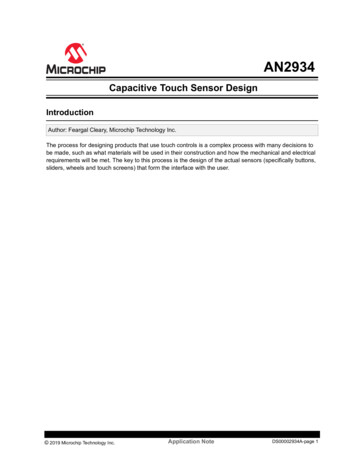
Transcription
AN2934Capacitive Touch Sensor DesignIntroductionAuthor: Feargal Cleary, Microchip Technology Inc.The process for designing products that use touch controls is a complex process with many decisions tobe made, such as what materials will be used in their construction and how the mechanical and electricalrequirements will be met. The key to this process is the design of the actual sensors (specifically buttons,sliders, wheels and touch screens) that form the interface with the user. 2019 Microchip Technology Inc.Application NoteDS00002934A-page 1
AN2934Table of ContentsIntroduction.11. Self-Capacitance Sensors. 41.1.1.2.Self-Capacitance Measurement. 4Sensor Design.52. Touch Cover Effect. 153. Shielding.163.1.3.2.3.3.Passive Shield.16Active Shield.18Radiated Emissions.224. Mutual Capacitance Sensors.244.1.Mutual Capacitance Measurement.245. Sensor Design. 265.1.5.2.5.3.5.4.5.5.Touch Capacitance Model. 26Button Sensor Design. 27Slider Sensor Design.30Wheel Sensor Design.32Surface Sensor Design. 346. Touch Cover Effects.387. Shielding.397.1.7.2.Passive Shield.39Moisture Tolerance. 408. Appendix A. 429. Appendix B. 4310. Appendix C. 44The Microchip Web Site. 45Customer Change Notification Service.45Customer Support. 45Microchip Devices Code Protection Feature. 45Legal Notice.46Trademarks. 46 2019 Microchip Technology Inc.Application NoteDS00002934A-page 2
AN2934Quality Management System Certified by DNV.47Worldwide Sales and Service.48 2019 Microchip Technology Inc.Application NoteDS00002934A-page 3
AN2934Self-Capacitance Sensors1.Self-Capacitance Sensors1.1Self-Capacitance MeasurementSelf-capacitance touch sensors use a single sensor electrode to measure the apparent capacitancebetween the electrode and the DC ground of the touch sensor circuit.Figure 1-1. Self-Capacitance Sensor Model-The base capacitance is formed by the combination of parasitic, sensor and ground return capacitance.In combination, these form the ‘untouched’ capacitance that is measured during calibration and used asreference to detect a capacitance change indicating touch contact.Figure 1-2. Self-Capacitance Model with Touch ContactWhen a touch contact is applied, the apparent sensor capacitance is increased by the introduction of aparallel path to earth through the ‘Human Body Model’. The touch capacitance Ct forms a seriescombination with the HBM capacitance Ch and ground to earth capacitance Cg. This increase is referredto as the ‘Touch Delta’.Note: The HBM resistance Rh does not affect touch sensitivity.Ct May be approximated as a parallel plate capacitor 2019 Microchip Technology Inc.Application NoteDS00002934A-page 4
AN2934Self-Capacitance Sensors A user’s fingertip placed onto a solid surface may be approximated as a disc with the diameterbetween 5-10 mm. 8 mm is estimated as a typical user’s fingertip diameter and is used in theexamples in this document. Capacitor plates are the touch sensor electrode and the user fingertip Electrolyte is the touch cover 0.1 pF up to 5 pF depending on sensor size and touch cover thickness/materialCh Human body model capacitance Self-capacitance of the human body with respect to earth 100 pF to 200 pF for an adult depending on physiqueCg Capacitance of the coupling between the application DC ground and earthDepends on application type and power systemAs little as 1 pF in a small battery powered deviceInfinite capacitance/short circuit where the DC ground is connected directly to earthIn series capacitors, the dominant effect is that of the smallest capacitor.Equation 1-1. Series Capacitor Combination 1 2 1 2Ct is much smaller than Ch, and in most applications Ct is also much smaller than Cg, so Ct determinesthe change in measured capacitance.For example:Ct 1 pF, Ch 100 pF, Cg 100 pF CTotal 0.98 pF CTotal is almost equal to CtBut in an application where Cg is very low, e.g., 2 pF, sensitivity will be reduced significantly.Ct 1 pF, Ch 100 pF, Cg 2 pF CTotal 0.662 pF Measured touch delta is reduced by 33%1.2Sensor Design1.2.1Touch Capacitance ModelWhen designing sensors, a simple approximation of Ct may be derived from the parallel plate capacitorformula. 2019 Microchip Technology Inc.Application NoteDS00002934A-page 5
AN2934Self-Capacitance SensorsNote: This approximation loses accuracy where the area dimensions are less than an order ofmagnitude greater than the distance dimension.Equation 1-2. Parallel Plate Capacitor 0 Where ‘A’ is the parallel area, ‘ϵ’ is the permittivity of the electrolyte, i.e., vacuum permittivity ϵ0 x Relativepermittivity ϵr and ‘d’ is the thickness of the touch cover. The strongest touch delta is achieved with a large sensor electrode, thin touch cover and highpermittivity cover material.Example:Touch sensor electrode: 12 mm diameter discTouch cover: 1 mm plastic with relative permittivity ϵr 2Touch contact: 8 mm diameter disc Use the area of the smaller plate – the user fingertip – to calculate the capacitance1.2.2 8.85 12 2 0.00005027 / 0.001 .89 Button Sensor DesignThe simplest implementation of a capacitive sensor is a button, where the sensor consists of a singlenode and is interpreted as a binary state: In Detect or Out of Detect. When the touch delta – the digitizedmeasurement of touch capacitance Ct – exceeds the touch threshold the sensor is In Detect.The sensor is characterized by a user touch or touch emulator such as a conductive bar, which isconnected to earth via a human body model circuit. The threshold is set to a proportion – often 50% – ofthe maximum touch delta.Figure 1-3. Button Sensor Delta and Threshold 2019 Microchip Technology Inc.Application NoteDS00002934A-page 6
AN2934Self-Capacitance SensorsElectrode ShapesAn electrode is simply the patch of conductive material on the substrate that forms the sensor. Commonshapes are round or rectangular solid areas although any shape with sufficient touch contact area may beused. Corners should be rounded to reduce the concentration of electric fields which may increase theoccurrence of Electrostatic Discharge (ESD) to the sensor pad.Figure 1-4. Standard Button ShapesIt is also possible to use a hatched pattern (such as a 50% mesh fill) for the electrode if desired. Thistends to reduce the load capacitance of the sensor electrode, but also reduces the area interacting withthe touch so there is a proportional drop in sensitivity.Figure 1-5. Standard Buttons with Mesh FillTouch Target SizeThe touch sensor electrode should be large enough that a touch contact does not need to be preciselyplaced to activate the sensor. If the sensor electrode is smaller than the user’s fingertip, then sensitivity isreduced by the smaller effective area. For example, an 8 mm touch sensor with an 8 mm touch contactwill only show maximum delta when the contact is placed directly at the center of the electrode. 2019 Microchip Technology Inc.Application NoteDS00002934A-page 7
AN2934Self-Capacitance SensorsFigure 1-6. 8 mm Touch SensorBy increasing the size of the sensor, the user may place a contact anywhere over the sensor area with noloss in sensitivity. The effective parallel area of the touch contact is limited by the size of the user’sfingertip, not the sensor area.Figure 1-7. 12 mm Touch SensorHand ShadowAn unnecessarily large sensor electrode will show an unintended proximity effect due to coupling to anapproaching hand before the fingertip makes contact.Pin LoadingLarge sensors have higher self-capacitance, and the effect is increased if the sensor is located close toother circuitry including other sensors.Larger load capacitance causes increased time constant and so the sensor takes longer to charge,discharge and measure. This can lead to deterioration in touch detect latency and power consumption.Depending on measurement technology, high capacitance sensors may have reduced sensitivity or mayexceed the range of the analog front-end compensation circuitry.Note: See 8. Appendix A for device specific information on maximum sensor capacitance.Electrode SeparationIndividual sensor electrodes should be sufficiently separated so that touching one key does not cause anunintentional capacitance change on the neighboring keys, which could be misidentified as another touchcontact. Recommended spacing between sensor electrodes is 4 mm touch cover thickness. In manycases it is necessary to trade off sensor size and sensor separation for a dense UI.Table 1-1. Touch Key Dimensions1.2.3MinTypicalMaxKey Size8 mm12 mm20 mmSeparation3 mm6 mm—Slider Sensor DesignA slider is simply a row of two or more touch sensor electrodes which are measured as individualsensors. The measured touch deltas are combined to determine the position of a touch contact withincreased resolution by interpolation between the sensors. 2019 Microchip Technology Inc.Application NoteDS00002934A-page 8
AN2934Self-Capacitance SensorsWith large sensors and no spatial interpolation, the consistency of the reported touch position vs actualposition is very poor. As a contact moves across the slider, most of the time there is a touch contact onlyon one of the four electrodes. Position interpolation can only occur while the contact is crossing from onesensor to the next.Figure 1-8. Slider Position without InterpolationThis may be improved by reducing the sensor size and increasing the number of sensors. If the sensorpitch is reduced to ½ the width of a touch contact (i.e., sensor pitch 4 to 5 mm) then there will alwaysbe two to three sensor electrodes under the touch contact and several touch deltas are available forinterpolation wherever the contact is placed.Figure 1-9. Slider Position with InterpolationHowever, this is not always the optimal solution; for a long slider, the required number of sensorelectrodes may be more than the touch sensor controller supports or take longer to measure leading toan unacceptable touch latency.An alternative is to use spatial interpolation to ‘stretch’ the crossover position from one slider electrode tothe next. One example is the electrode shape illustrated below. This design has tapered overlapping 2019 Microchip Technology Inc.Application NoteDS00002934A-page 9
AN2934Self-Capacitance Sensorsedges to ensure that a touch contact anywhere along the length of the slider will always have contactarea with at least two sensor electrodes.Figure 1-10. Slider with Extended Interpolation0.5 mmMax4 mmChannel 0to 1 mmMaxMax4 mmChannel 1Make all sections equal width, repeatingsections as required for desired total width4 mm4 mmChannel 2Channel 3Adjust taper angle to fillremaining space4-6 mmper sectionSpacing of Slider ElectrodesEach element of the slider is loaded by its own self-capacitance and by the capacitance between it and itsneighboring electrodes as other electrodes are usually driven to a static DC level while a particular sensoris being measured.Note: The exception to this is the implementation of ‘Driven Shield ’. See 3. Shielding for furtherdetails.Recommended separation between the sensor electrodes depends on the size of the electrodes and theiroverlap lengths.A slider consisting of small keys without extended interpolation should have separation of 0.5 mmbetween electrodes. This improves touch delta consistency as the contact moves from one element to thenext, without the occurrence of reduced touch delta in between.Figure 1-11. Eight-Channel Slider/No InterpolationA slider consisting of large electrodes with long overlap lengths must have increased separation betweenthe sensor electrodes to avoid excess sensor load capacitance. In such a design, the separation may beincreased to 1 mm or more. 2019 Microchip Technology Inc.Application NoteDS00002934A-page 10
AN2934Self-Capacitance SensorsFigure 1-12. Six-Channel Slider with InterpolationAs with the button sensor design, sharp corners in the slider electrodes should be rounded to minimizesusceptibility to ESD. The points of the triangles forming the interpolated slider should be truncated to arounded end of 2 mm diameter.The electrodes must be close together for continuous sensitivity, but too little separation can causeincreased loading capacitance, as each sensor electrode has a parasitic load against its neighboringelectrodes. The spacing should be increased to maximum 1.5 mm in the cases when there are longparallel edges between electrodes due to extensive interpolation.Table 1-2. Button Slider DimensionsMinTypicalMaxSlider width8 mm12 mm20 mmElectrode length4 mm6 mm8 mm0.25 mm0.5 mm1 mmMinTypicalMaxSlider width8 mm12 mm20 mmElectrode length8 mm16 mm30 mm0.5 mm1 mm1.5 mmElectrode separationTable 1-3. Interpolated Slider DimensionsElectrode separation1.2.4Wheel Sensor DesignA wheel sensor consists of a row of three or more sensor electrodes which are arranged into a circle.Note: At least three electrodes are needed as position calculation requires unique crossover regions.A wheel sensor operates in the same way as a slider sensor, with the single exception being that it iswrapped around from Channel n to Channel 0 so there are no end electrodes in the design.As with a slider, the simplest implementation is to arrange buttons in a circle. At least three electrodes areused. 2019 Microchip Technology Inc.Application NoteDS00002934A-page 11
AN2934Self-Capacitance SensorsFigure 1-13. Simple Three-Channel WheelChannel 212–20 mmChannel 15 mm90 Channel 0A larger wheel may be implemented by increasing the number of sensor keys used or by increasing thesegment interpolation, as in the case of the slider.Figure 1-14. Eight-Electrode Wheel without Extended Interpolation0.25 to 1 mm8 mm - 20 mmFigure 1-15. Three-Electrode Wheel with Extended InterpolationMax4 mm0.1 to 0.5 mm GapChannel 25–9 mm5–8 mmPer RingChannel 0 2019 Microchip Technology Inc.Channel 1Application NoteDS00002934A-page 12
AN2934Self-Capacitance SensorsAs with other sensors, sharp corners in the electrodes need to be rounded to minimize susceptibility toESD. The points of the triangles forming the interpolation should be truncated to a rounded end of 2 mmdiameter.Wheel electrodes must be close together for continuous sensitivity, but too little separation can causeincreased loading capacitance, as each sensor electrode has a parasitic load against its neighboringelectrodes. The spacing should be increased up to max 1.5 mm in the cases when there are long paralleledges between electrodes due to extensive interpolation.Table 1-4. Button Wheel DimensionsMinTypicalMaxWheel width8 mm12 mm20 mmElectrode length4 mm6 mm8 mm0.25 mm0.5 mm1 mmMinTypicalMaxSlider width8 mm12 mm20 mmElectrode length8 mm16 mm30 mm0.5 mm1 mm1.5 mmElectrode separationTable 1-5. Interpolated Wheel DimensionsElectrode separation1.2.5Surface Sensor DesignA self-capacitance touch surface consists of ‘row’ and ‘column’ electrodes whose measurements areused to implement slider functionality in both the horizontal and vertical directions.The simplest pattern is the ‘diamond’ pattern shown below. In this example, sensors H0 to H5 provide thehorizontal location of a touch contact, while V0 to V4 provide the vertical location.Figure 1-16. Touch Surface Diamond PatternThe sensor is characterized by its pitch and separation: Horizontal/vertical sensor pitch is the distance between column/row electrode centers. Sensor separation is the perpendicular distance between the parallel edges of adjacent diamonds.Each sensor electrode is formed by chains of squares (symmetrical node pitch) or diamonds(asymmetrical pitch) which are turned 45 to provide improved interpolation in the horizontal and verticaldirections. 2019 Microchip Technology Inc.Application NoteDS00002934A-page 13
AN2934Self-Capacitance SensorsElectrode PitchThe ideal electrode pitch is approximately 5 mm for a user contact of 8 mm. This ensures that a contactplaced anywhere on the surface will include an overlap area with at least two sensor electrodes in eachdimension; thus, the contact permits the best interpolation of the touch position.For larger touch surface designs many sensor electrodes are required to maintain optimum linearity. Moresensors require more time to measure and increased power consumption. In many cases the designermust compromise between sensor linearity and the number of sensors.Extended InterpolationAs with sliders and wheels, it is possible to design electrodes for a surface sensor with increasedinterpolation between adjacent sensors. This allows the designer to increase the electrode pitch whilemaintaining linearity.One example is the ‘flower’ pattern, where each element of the sensor array has increased spatialinterpolation with its neighbors.Figure 1-17. Touch Surface Flower PatternAs with other sensors, sharp corners in the electrodes have to be rounded to minimize susceptibility toESD. The points of the triangles forming the interpolation should be truncated to a rounded end of 2 mmdiameter.Note: Two-touch detection requires separation of at least 2x sensor pitch between contact centers.Table 1-6. Diamond Patten DimensionsTypeElectrode pitchElectrode separationMinTypicalMax4 mm6 mm10 mm0.25 mm0.5 mm1 mmMinTypicalMax4 mm6 mm10 mm0.5 mm1 mm1.5 mmTable 1-7. Flower Patten DimensionsTypeElectrode pitchElectrode separation 2019 Microchip Technology Inc.Application NoteDS00002934A-page 14
AN2934Touch Cover Effect2.Touch Cover EffectA thicker touch cover increases the distance between the user’s fingertip and the sensor electrode. Thiscauses reduced capacitance between the user and the sensor electrode, and a proportional decrease intouch sensitivity.This can be compensated by increasing the size of the electrode. A thicker cover also has the effect ofdiffusing the electric field formed between the fingertip and electrode, and thus a larger electrode caneffectively increase the contact area.For maximum sensitivity each sensor electrode should be designed to extend beyond the touch contactby at least the thickness of the touch cover.All types of sensors should be wide enough to extend beyond the dimensions of a touch contact by atleast the thickness of the touch cover on both inside and outside. See examples below: 1 mm touch cover/8 mm contact: recommended width 10 mm 3 mm touch cover/8 mm contact: recommended width 14 mm 6 mm touch cover/8 mm contact: recommended width 20 mmIn an interpolation sensor (slider, wheel, or surface), the diffusion of the electric fields results in anextended crossover area between adjacent electrodes and improved accuracy in the reported contactposition. 2019 Microchip Technology Inc.Application NoteDS00002934A-page 15
AN2934Shielding3.ShieldingIn many applications it is necessary to shield the touch sensors to prevent incorrect activation. This maybe caused by Electromagnetic Interference (EMI) or by touch contact at a location that is not intended tobe touch sensitive.A variety of shield types may be used with self-capacitance sensors depending on the measurementtechnology.These may be generally classed into ‘passive’ shield, where a shielding electrode is driven to a DC level,and ‘active’ shield, where a sequence of different voltage levels is driven to the shield during themeasurement cycle.Note: See 9. Appendix B for device specific availability.3.1Passive ShieldA shield electrode may be placed around the sensor electrode, or between the sensor and sources ofinterference, that may impair correct operation. A passive shield is an implementation where the shieldelectrode is driven to a constant DC level during the sensor measurement. Usually connected to DC groundMay also use VDD or any ground referenced DC levelRear flood prevents touch or EMI from behindCoplanar flood provides better isolation of touch sensorsMay be hatched to reduce capacitive loadDetrimental to moisture toleranceEffect of Ground LoadingDC or ground loading adds directly to the sensor base capacitance thus increasing the time constant.Note: Ground in this context includes any conductor close to the sensor or its trace that is referenced toDC ground. This encompasses any circuit element or signal track that is nearby.Idle sensors are usually driven to a DC level and the traces to these idle channels behave as thoughconnected to ground. If a trace leading to key 1 is routed past key 2, then key 2 is loaded as though to aground trace.Where the ground referenced electrodes or traces are close to the touch sensor there is a reduction intouch sensitivity as the electric field emitted by the sensor electrode is attracted to the ground plane. Thisreduces the strength of the electric field available to interact with the user touch contact.Rear Ground ShieldSometimes it is desirable to shield an electrode on its rear side to prevent false detection from movingparts to the rear, or to prevent interference from switching signals, for example, from backlighting or drivercircuitry.If a driven shield is not possible, then a ground plane may be used. This should be connected directly tothe circuit ground at a single point.A rear ground plane may significantly reduce the sensitivity of the touch sensors, as the DC groundattracts the electric field emitted by the touch sensor electrode. This should be taken into consideration 2019 Microchip Technology Inc.Application NoteDS00002934A-page 16
AN2934Shieldingparticularly where the touch cover may be thicker than the separation between electrode and groundlayers.To alleviate this problem the electrode and ground plane should be separated by the maximum distancepossible. For example, on a multilayer PCB, touch sensors should be on the top layer and ground on thebottom.Additionally, the ground shield may be reduced to 50% or 25% hatched fill, which reduces the sensorloading while still providing the shield effect.If the application does not risk accidental touch contact from the rear of the sensor board, the rear groundplane may be cut out behind the sensor keys. This reduces capacitive loading of the sensors whileproviding sensor isolation from other circuit components or EMI.Coplanar Ground ShieldA coplanar ground shield may be implemented to improve isolation between touch sensors, to reduceEMI to the touch sensors and to reduce the interference caused by common mode noise when a touchcontact is present.As a coplanar shield does not overlap the area of the touch sensors, a solid pour should be used.To minimize the loss in sensitivity, the ground shield should be kept at a distance from any touch sensorof approximately 2 mm, which may be increased for large sensor electrodes.Figure 3-1. Coplanar Ground Plane SeparationGap of at least 2 mm betweensensor and ground planeSensorGroundPlaneExample LayoutFigure 3-2. Sensor Layout with Front and Rear Hatched Ground Plane 2019 Microchip Technology Inc.Application NoteDS00002934A-page 17
AN2934ShieldingTable 3-1. Sensor to Ground SeparationMin1 mmTypicalMax2 mm3 mmLarger electrodes should have increased ground separation to avoid too much load capacitance on thesensor electrodes.3.2Active Shield3.2.1Driven Shield Drives ‘shield’ electrode with a sequence of DC levels synchronized to the sensor measurementRequires a dedicated shield electrodeReduces or eliminates loading of sensors due to capacitance with neighborsRear shield prevents touch from behindImproved water toleranceAny ground referenced trace near a sensor will load that sensor, reduce its sensitivity and may evenproduce false touches in certain environmental conditions, such as specifically wet or very humidconditions.Figure 3-3. Driven Shield CircuitTwo classes of driven shield are available on Microchip touch sensor devices: three-level shield and twolevel shield.Three-Level ShieldThe shield is driven through a sequence of voltages matching the electrode potential at each stage in themeasurement. This effectively decouples the touch sensor from the ground, reducing the capacitiveloading and provides an electrical shield to EMI improving the Signal to Noise Ratio (SNR) of the sensor.By placing the shield between the sensor and other circuit components, the operation in the presence ofmoisture is greatly improved. 2019 Microchip Technology Inc.Application NoteDS00002934A-page 18
AN2934ShieldingTable 3-2. Sensor to Shield Separation – Three-Level ShieldMinTypicalMax0.2 mm0.5 mm3 mmTwo-Level ShieldDrives a charge pulse during the sensor measurement which shields the sensor from outside influencewhile additionally boosting the sensitivity of the sensor.The shield electrode is driven with pulses synchronized to the measurements. These pulses have theeffect of boosting the self-capacitance measurement by injection of additional charge to the sensorcapacitance. Greater touch sensitivity is achieved as a user touch contact interacts with the electric fieldbetween shield and sensor as well as the electric field between sensor and shield and the electric fieldbetween sensor and ground.Sensor load capacitance is reduced as the shield isolates the sensor from nearby ground referencedcircuit components.Table 3-3. Separation between Sensor and Shield ElectrodesMin1 mmTypicalMax2 mm3 mmDriven Shield ExamplesFigure 3-4. Driven Shield LayoutAlternatively, a ‘ring shield’ may be used to isolate each of the sensor electrodes from each other and theground plane. The ring shield consists of a shield electrode wrapped around each touch sensor. Theelectrode should be at least 2 mm wide and separated from the touch sensor by approximately 2 mm.Note: The shield should not form a complete ring around the sensor electrode as this may lead toproblems with RF noise. Breaking the ring also allows simplified routing and enables a single layer sensordesign. 2019 Microchip Technology Inc.Application NoteDS00002934A-page 19
AN2934ShieldingFigure 3-5. Ring Shield Layout3.2.2Driven Shield Some devices have the facility to drive the ‘shield’ signal – three-level or two-level – not only to adedicated shield electrode but also to other touch sensor electrodes on the UI.Even in the case where all pins are used as touch sensors and there are no pins available for a shield,Driven Shield can be used to drive the other sensors as shield. In the application examples shown inFigure 3-6, Y0 is the active sensor and all other electrodes are driven as shield.Figure 3-6. Driven Shield ExamplesFigure 3-7. Sensors with Ground in Close ProximityIn Figure 3-7, sensor Y0 is measured while all other sensors are held static at VDD. There is also aground flood or signal near the sensors. In this scenario, additional capacitance exists between Y0 andground. Charge driven into Y
between the electrode and the DC ground of the touch sensor circuit. Figure 1-1. Self-Capacitance Sensor Model-The base capacitance is formed by the combination of parasitic, sensor and ground return capacitance. In combination, these form the 'untouched' capacitance that is measured during calibration and used as

